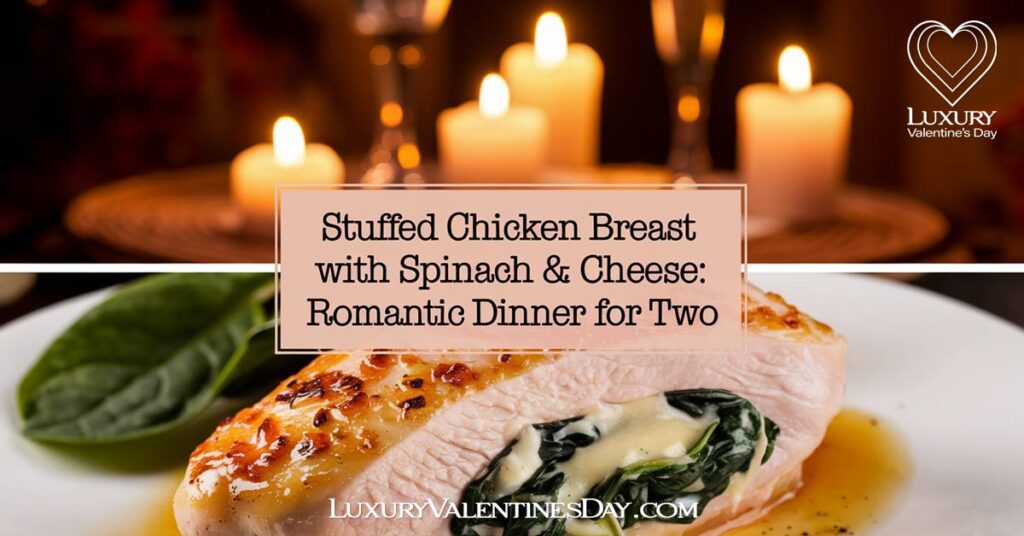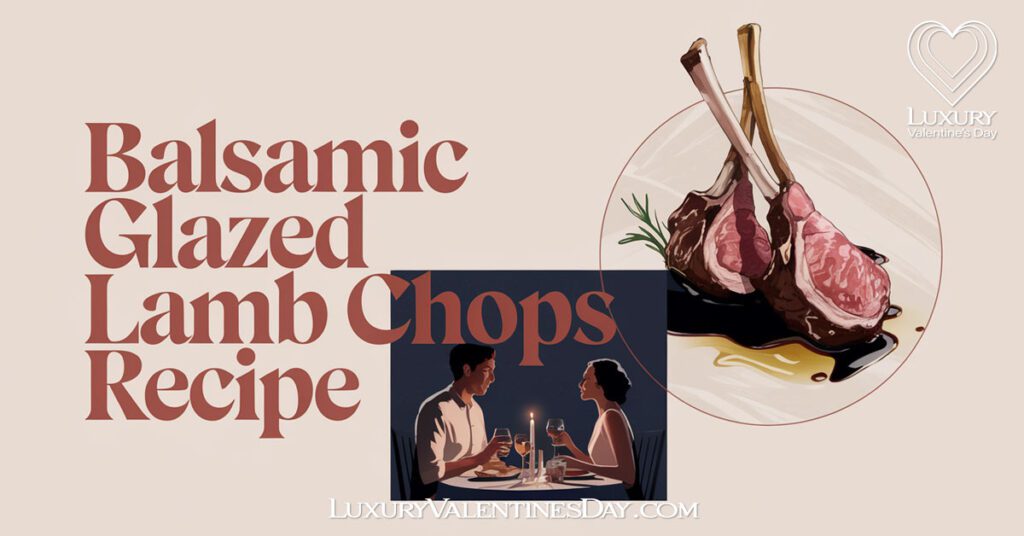
Table of Contents
ToggleDecoding the Palette: Valentine Colors Meaning and Emotion
Valentine’s Day is a celebration rich in hues, each with its own valentine day colors meaning, transcending beyond the classic red to a spectrum that narrates the diverse stories of love. This exploration delves into the colors associated with Valentine’s Day, revealing how each shade uniquely captures the essence of our deepest feelings and affections.
Key Takeaways:
- Discover Color Meanings: Explore the unique symbolism behind each Valentine color.
- Innovative Celebration Ideas: Ideas for integrating a diverse palette into your Valentine’s Day festivities.
- Colorful Traditions and Trends: Traditional and modern influences in Valentine’s Day colors.
- Elegance and Thoughtfulness: Using colors to add sophistication to your Valentine’s experience.
History of Valentine’s Day Colors Origin
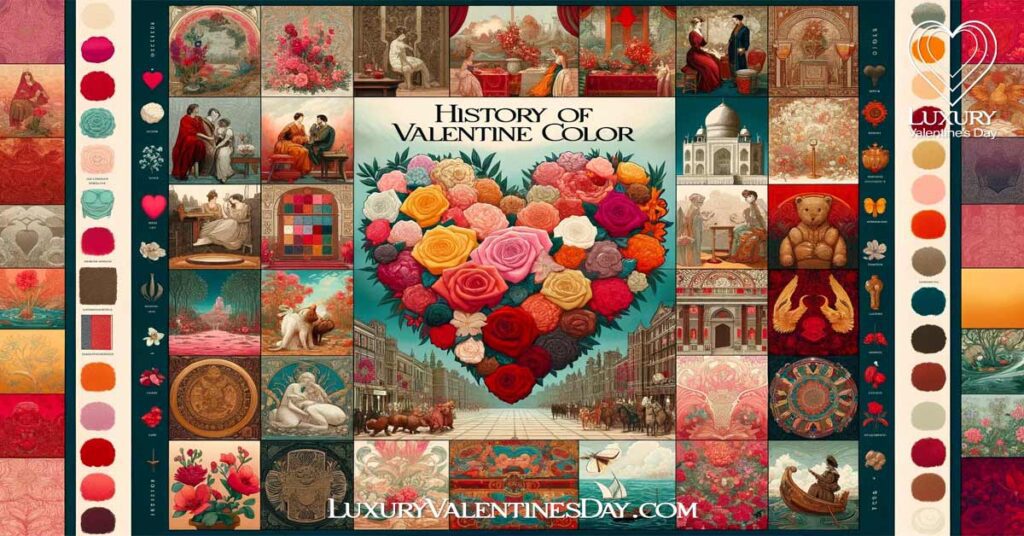
As we delve into the vibrant world of Valentine’s Day, it’s fascinating to trace the origins of its iconic color palette. This journey through history uncovers how the celebration’s colors evolved from ancient traditions to modern-day symbols of love. From the deep reds of the Roman festivals to the delicate pinks and purples of Victorian floriography, each color carries a legacy that has shaped our modern Valentine’s Day. This section invites you on a historical adventure to understand how these colors have woven themselves into the fabric of Valentine’s Day, enriching our celebrations with their storied pasts.
Ancient Beginnings and Historical Evolution
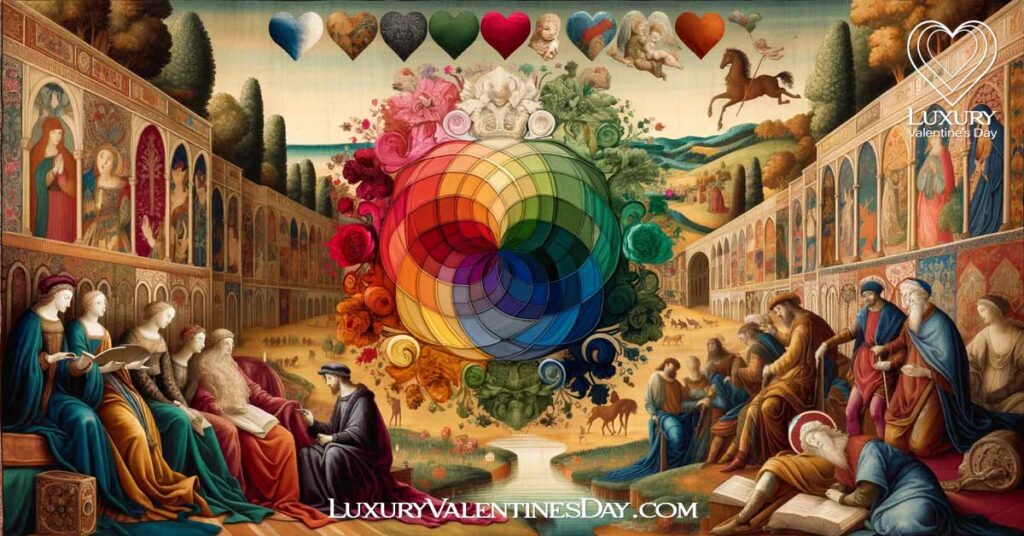
Tracing Back to Ancient Civilizations
The journey of Valentine’s Day colors begins in the ancient world, where color symbolism played a pivotal role in festivals and rituals. In ancient Rome, the Lupercalia festival stands out as a precursor to modern Valentine’s Day. Celebrated in mid-February, this festival was steeped in the color red, a vivid symbol of fertility and love. This early association of red with passion and life laid the foundation for its enduring connection with love and romance.
Medieval and Renaissance Romance
During the Middle Ages, medieval Valentine’s Day, and the Renaissance, the use of color in expressing love evolved in art and literature. Red, already established as a symbol of love, was joined by other colors. Green symbolized hope and renewal in love, while blue represented constancy and loyalty. This era’s rich tapestries, paintings, and romantic literature used these colors to convey deep emotional narratives, further embedding them in the cultural consciousness as symbols of various facets of love.
Transition Through the Centuries
As we moved through history, these color associations with love and Valentine’s Day continued to evolve. The Industrial Revolution and the advent of mass-produced Valentine’s Day cards in the 19th century popularized these colors further. Red remained predominant, but other colors began to gain prominence, each representing different aspects of love. This evolution reflects the changing societal norms and cultural practices, shaping the modern palette of Valentine’s Day colors that we celebrate today.
Cultural Influences and Global Perspectives
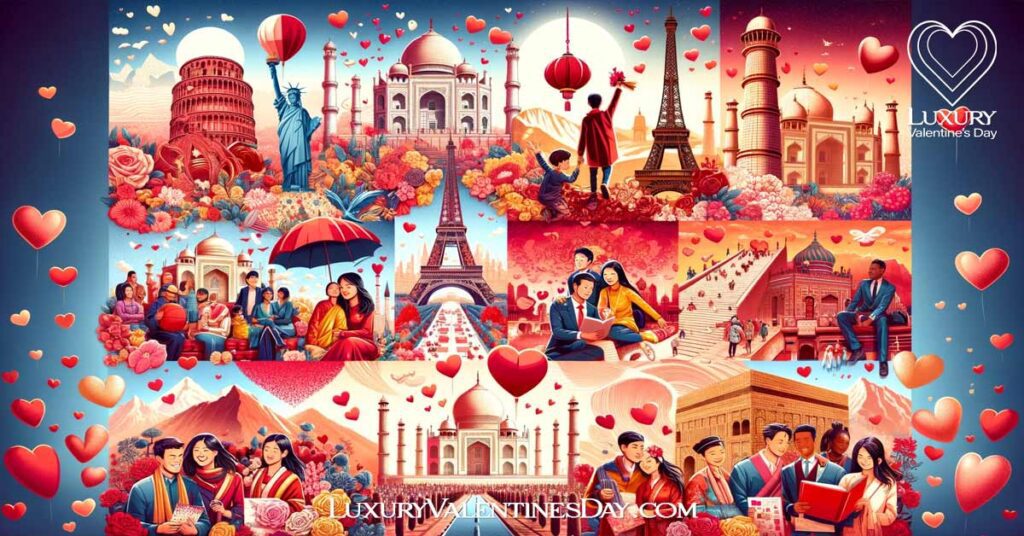
The colors of Valentine’s Day, as we know them today, are not just a product of historical evolution but also of diverse cultural influences from around the globe. This melting pot of traditions and interpretations has given us a richer, more varied palette of Valentine’s Day colors.
Varied Cultural Interpretations
Across different cultures, colors have taken on unique meanings, many of which have been integrated into the celebration of love and Valentine’s Day. In some Eastern cultures, for instance, red maintains its universal association with love and luck, while in others, pink has come to be seen as a tender, youthful expression of affection. Green, often associated with nature and rebirth in many cultures, has also found a place in Valentine’s Day as a symbol of new beginnings and growth in relationships.
In Latin American cultures, bright and vibrant colors like orange and yellow are seen as expressions of warmth, happiness, and vitality, contributing to the festive mood of Valentine’s Day. Similarly, in some Western cultures, the elegance of white and the purity it represents have been embraced in Valentine’s Day celebrations, particularly in floral arrangements and decor.
Modern Globalization of Valentine’s Day Colors
The 20th and 21st centuries have seen a significant globalization of Valentine’s Day, with the holiday being celebrated in various forms around the world. This global spread has been accompanied by a blending and adaptation of color meanings. The commercialization of the holiday, driven by industries such as greeting cards (check out our article about Valentines cards history), floristry, and confectionery, has played a crucial role in popularizing certain colors.
Marketers and advertisers have tapped into the emotional resonance of colors, using them to craft appealing Valentine’s Day themes that transcend borders. This has led to the emergence of a modern palette for Valentine’s Day, one that is more inclusive and reflective of a global perspective on love and affection. As a result, Valentine’s Day today is not just a day of reds and pinks but a celebration that includes a whole spectrum of colors, each representing different aspects of love as influenced by cultural diversity and global connectivity.
The Victorian Era and the Rise of Floriography
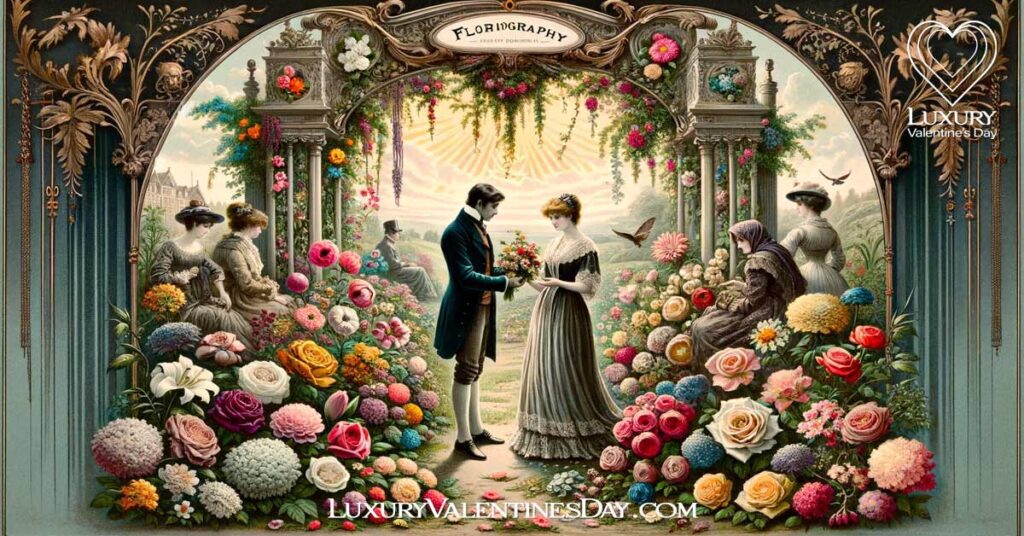
The Victorian era marked a significant period in the history of Valentine’s Day colors, introducing a nuanced language of flowers known as floriography. This period refined the use of color in expressing love, embedding deeper meanings into the colors associated with Valentine’s Day.
Floriography’s Impact
During the Victorian era, floriography became a popular way to convey emotions and messages, including those of love and affection, through the choice of flowers and their colors. This era’s fascination with hidden meanings and coded messages led to a more intricate use of color in Valentine’s Day traditions. While we explore floriography in greater detail later, it’s important to note here that this practice played a crucial role in shaping the modern color associations of Valentine’s Day.
Color Symbolism in Victorian Romance
In Victorian times, specific colors began to carry coded messages within the context of romance and courtship. Red roses, for instance, were a direct expression of deep love and passion. Pink flowers, on the other hand, were often used to convey admiration and a more tender, gentle love. Lavender, with its delicate hue, was associated with enchantment and sometimes even love at first sight.
The use of white in floral arrangements conveyed purity and innocence, often symbolizing a new beginning or a fresh start in a relationship. Yellow, though sometimes associated with jealousy, was also used to express happiness and friendship, adding another layer to the romantic narrative of the time.
This subtlety and richness in color symbolism during the Victorian era significantly influenced how we perceive and use colors in modern Valentine’s Day celebrations. It added layers of meaning to the colors we choose to express our feelings, making Valentine’s Day a more nuanced and emotionally expressive holiday.
Learn more about the history of Valentine’s Day here.
20th Century to Present – Commercialization and Popular Culture
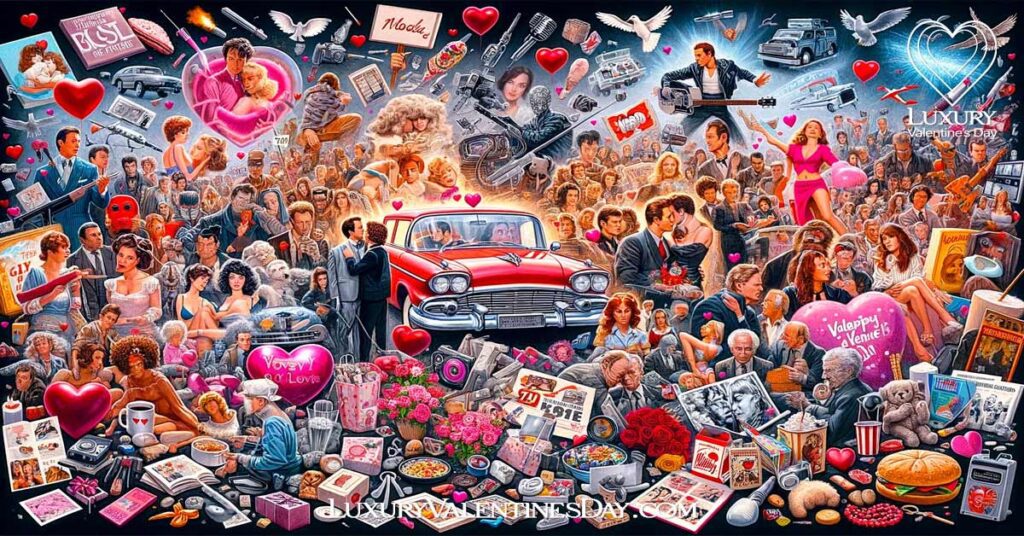
The 20th century ushered in an era where commercialization and popular culture began to play pivotal roles in shaping the colors of Valentine’s Day, turning it into the vibrant celebration we know today.
Commercial Influence on Color Choices
With the rise of mass production and marketing in the 20th century, commercial entities like greeting card companies and florists started to exert a significant influence on the color palette of Valentine’s Day. Red, symbolizing love and passion, was heavily promoted in Valentine’s Day marketing campaigns, further cementing its status as the quintessential color of the holiday. Pink followed suit, capitalizing on its association with romantic love and affection.
These companies also began to introduce a broader range of colors to appeal to diverse tastes and sentiments. For example, the inclusion of purple and lavender hues in Valentine’s Day products offered a touch of luxury and enchantment, while white and yellow were marketed for their connotations of purity, friendship, and new beginnings.
Pop Culture and Media Impact
The impact of media and pop culture in the 20th and 21st centuries cannot be understated in the context of Valentine’s Day colors. Films, television shows, and music often portrayed Valentine’s Day scenes filled with red and pink, reinforcing these colors’ association with the holiday. Romantic comedies, in particular, played a significant role in popularizing certain Valentine’s Day tropes, including the use of specific colors to set the mood for love and romance.
Advertising campaigns, too, leveraged these color associations, often using them to evoke emotions and sell a wide range of Valentine’s Day products. From chocolates wrapped in red foil to pink champagne, the colors of Valentine’s Day were used to create an atmosphere of romance and to encourage consumers to express their feelings through color-coded gifts.
In this modern era, Valentine’s Day has become not just a day of personal celebration but a cultural phenomenon, with its colors deeply embedded in the collective consciousness. The commercialization and influence of popular culture have ensured that these colors continue to play a significant role in how we express love and affection on this special day.
An Insight into Color Theory: Deciphering the Language of Colors
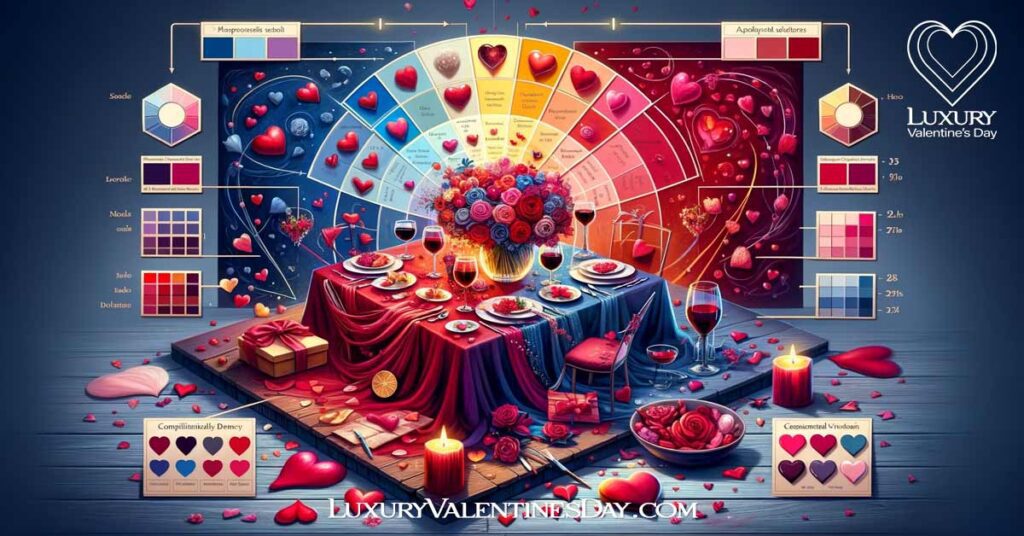
In the realm of Valentine’s Day celebrations, the choice of colors goes beyond mere preference; it’s deeply rooted in the science and psychology of color theory. This section addresses the question, “What is color theory?” and explores how its principles apply to the nuances of Valentine’s Day, shaping our perceptions and emotional responses.
What is Color Theory: The Basic Principles
Color theory [1] is a cornerstone in understanding how colors interact, how they can be combined, and the impact they have on our emotions and perceptions. At its core, color theory examines the relationships between colors on the color wheel, including complementary, analogous, and triadic schemes. It also explores concepts such as hue, saturation, and brightness, all of which play a role in how we perceive colors.
In the context of emotions and aesthetics, color theory becomes particularly significant. Certain colors, due to their psychological impact, evoke specific emotions. For example, red is often associated with passion and intensity, while pink, being softer, evokes tenderness and romance. Understanding these emotional associations is key in creating the desired ambiance for Valentine’s Day, whether it’s passionate, playful, or affectionate.
Color Theory in Valentine’s Celebrations
Applying color theory to Valentine’s Day celebrations opens up a world of possibilities, allowing for a deeper understanding and more intentional use of colors in setting the tone for this special day.
In choosing colors for Valentine’s Day themes, the principles of color theory guide us in creating a specific mood and atmosphere. Beyond the traditional reds and pinks, which are universally recognized as colors of love and romance, color theory encourages us to explore a broader palette, each with its own unique emotional resonance.
For instance, using complementary color schemes, such as red and green, can create a visually stimulating environment that is both exciting and balanced. This combination can be particularly effective in vibrant, lively Valentine’s celebrations. On the other hand, analogous color schemes, like pink, red, and purple, offer a harmonious and visually cohesive look, ideal for creating a romantic and intimate setting.
Do you want to learn more about color theory? Check out these books on Amazon.
Color theory also emphasizes the importance of color saturation and brightness in evoking different feelings. Brighter, more saturated colors like vivid reds and deep purples can energize and intensify the feeling of passion, while softer, less saturated colors like pastel pinks and lavenders suggest gentleness and a more tender form of love.
Furthermore, color theory allows for the personalization of Valentine’s Day celebrations. Understanding the emotional impact of different colors means you can tailor the color scheme to reflect the unique nature of your relationship or the specific mood you wish to create. Whether it’s the warmth of burnt orange for a cozy, intimate dinner or the elegance of gold tones for a luxurious Valentine’s gala, color theory provides the tools to create a celebration that is not only visually stunning but also emotionally resonant.
Incorporating color theory into Valentine’s Day celebrations is not just about aesthetic appeal; it’s about creating experiences that resonate on an emotional level, making the day truly unforgettable.
Floriography: The Secret Language of Flowers

Floriography, or the language of flowers, has long been a whispered mode of communication, conveying emotions and messages through the choice of specific flowers and their colors. Here we delve into the intriguing world of floriography [1], exploring its origins, significance, and how it has been intricately woven into the fabric of Valentine’s Day celebrations. As we uncover the meanings behind various floral hues and arrangements, we reveal how this secret language has been used to express the inexpressible, allowing lovers to communicate their deepest affections and intentions without uttering a single word. Join us as we decode this blooming language, enhancing your understanding of how flowers and their colors can speak volumes in the celebration of love.
The Language of Flowers
Floriography, the language of flowers, is a form of communication that dates back centuries, with roots in various cultures and traditions across the globe. This intricate language, where each flower and its color convey specific messages, has a rich and fascinating history, particularly in the context of love and courtship.
The origins of floriography can be traced back to ancient civilizations such as the Greeks, Romans, and Egyptians, where flowers were used in religious and ceremonial contexts, often imbued with symbolic meanings. However, it was during the Ottoman Empire that the language of flowers began to take a more structured form, later spreading to Europe, where it reached its zenith during the Victorian era.
In Victorian England, where overt expressions of emotions were often frowned upon, floriography became a popular means of covert communication. Society’s strict etiquette rules led people to seek alternative ways to express their feelings, and flowers provided the perfect medium. Each flower and color came to represent different emotions: red roses for love, violets for faithfulness, and forget-me-nots for enduring memories, to name a few.
Books and guides on floriography became widely popular, allowing people to send nuanced messages through carefully chosen bouquets. A suitor might send a mix of flowers, each adding to a layered message of love, admiration, and devotion. Similarly, the receipt of certain flowers could be interpreted as a response, conveying acceptance, caution, or even rejection.
The significance of floriography extends beyond just the selection of flowers; the way flowers are presented and combined also plays a role in conveying the message. For instance, a rosebud facing upward signifies a heart unaware of love, while one facing downward indicates a love that has been rejected.
Today, while the strict rules of Victorian floriography may no longer apply, the sentiment behind using flowers to convey feelings remains. Modern Valentine’s Day celebrations continue to embrace the language of flowers, allowing individuals to express their emotions through the timeless beauty of floral arrangements and their colors.
Floriography Today

While the intricate codes of traditional floriography may not be as commonly used today, the essence of this language still resonates, especially in contemporary Valentine’s Day celebrations. The modern adaptation of floriography bridges the gap between its historical roots and the way we express love and affection in the present day.
Today, the choice of flowers and their colors for Valentine’s Day is often influenced by the traditional meanings established by floriography. Red roses, universally recognized as a symbol of deep love and passion, continue to be the most popular choice, echoing the sentiments of their Victorian counterparts. Pink roses, suggesting admiration and grace, and white lilies, symbolizing purity and innocence, are also favorites, reflecting the enduring legacy of floriography in modern times.
Moreover, the resurgence of interest in vintage and retro culture has seen a renewed appreciation for the subtleties of floriography. People are increasingly looking to convey more personalized and meaningful messages through their choice of flowers. This has led to a diversification in the types of flowers used for Valentine’s Day, with many opting for less traditional but equally meaningful blooms. For instance, sunflowers, symbolizing adoration and loyalty, and tulips, representing perfect love, have gained popularity.
Contemporary florists often play the role of modern-day floriographers, guiding customers in selecting the right flowers and colors to express their feelings. This practice not only adds a layer of thoughtfulness to gift-giving but also connects us to a rich historical tradition.
In addition, the digital age has facilitated the spread of knowledge about floriography, making it easier for individuals to research and understand the meanings behind different flowers and their colors. As a result, the language of flowers continues to be a vibrant and meaningful part of Valentine’s Day, allowing for a deeper, more symbolic expression of love and affection.
What are the Valentine’s Day Colors?
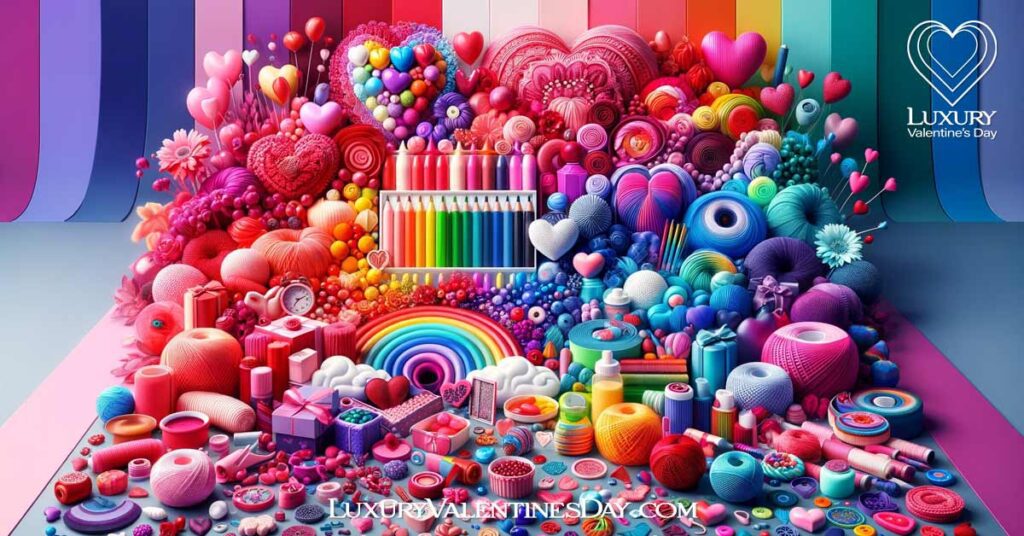
Valentine’s Day, a celebration synonymous with love and romance, is as much about color as it is about heartfelt emotions. This section delves into the myriad of colors that have become emblematic of Valentine’s Day, exploring each hue’s significance and the emotions they evoke. From the deep reds symbolizing passionate love to the soft pinks of budding romance, and the less traditional but equally expressive colors, we uncover the tapestry of hues that make Valentine’s Day a visually and emotionally rich celebration. Join us in this colorful exploration, as we unravel the meanings behind the Valentine’s Day palette and how these colors have come to define one of the most romantic days of the year.
If you want to learn more about what color you should be wearing on Valentine’s Day, we go into much more detail in our post “What Color To Wear on Valentine’s Day“.
Red: The Passionate Hue of Valentine’s Day
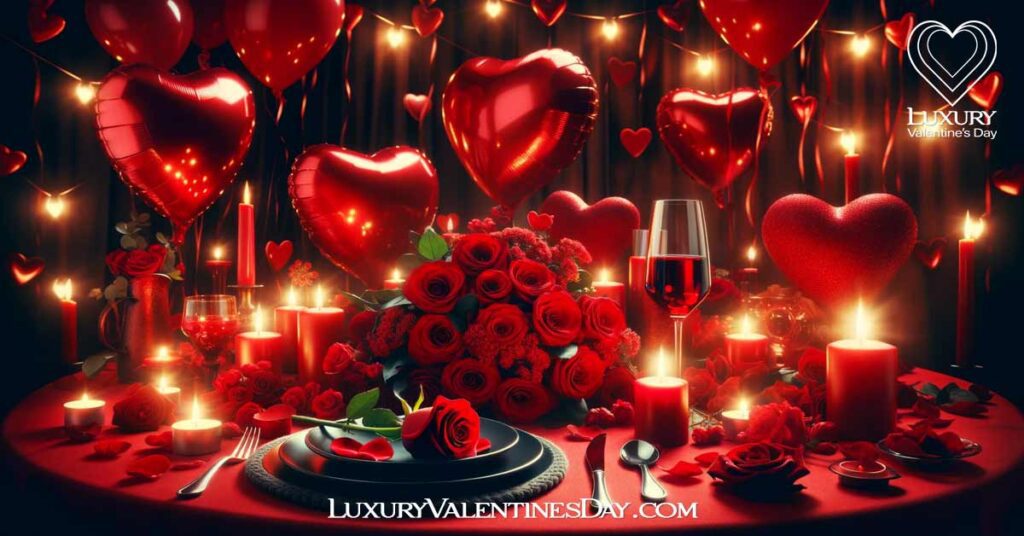
The Symbolism of Red
Red, often called the color of love, holds a place of honor on Valentine’s Day. Its deep, vibrant hue is symbolic of passion, desire, and deep emotional connections. This color resonates with the beating heart, the universal symbol of love, and embodies the intensity of romantic feelings. Red’s boldness captures the essence of love’s fervor, making it an emblematic and powerful color for Valentine’s Day.
Celebrating with Red
Embracing red in Valentine’s Day festivities can infuse the celebration with warmth and ardor.
- Decor: Set the stage for romance with red-themed decorations. Think red balloons, candles, and even rose petals to create a sensuous and inviting atmosphere. Adorn tables with red tablecloths or centerpieces featuring red roses for a classic touch.
- Gifts: Personalized gifts with red details, like a locket with a garnet stone, combine tradition with individuality. Plan a date night with a red theme, such as a candlelit dinner in a setting with rich, red tones.
- Fashion: Wearing red on Valentine’s Day is a bold expression of love. A striking red dress, a sharp red tie, or even red accessories can make a powerful romantic statement.
- Gastronomy: Incorporate red into your Valentine’s Day menu with dishes like red velvet cake or a glass of fine red wine, adding a layer of thematic indulgence to the celebration.
By weaving red into these aspects of Valentine’s Day, you can amplify the romantic ambiance, making the day even more memorable and filled with love.
Pink: The Tender Whisper of Valentine’s Day
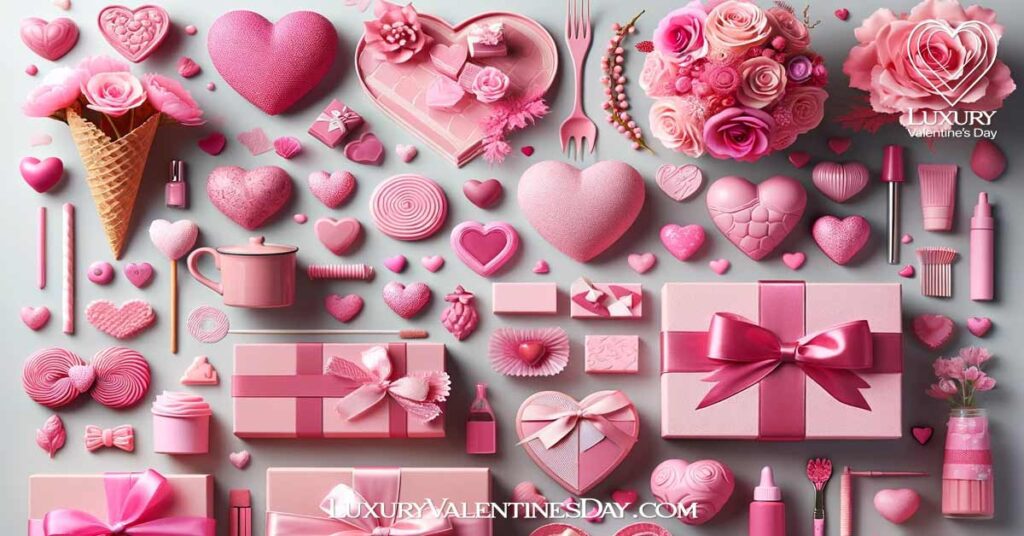
Unveiling Pink’s Romantic Essence
Pink, a softer counterpart to the fiery red, carries its own charm and significance on Valentine’s Day. It symbolizes a gentler form of love, often associated with the sweetness of new romance, affection, and playfulness. The color pink speaks of tenderness, nurturing, and a soft, delicate approach to love. It is the whisper of first love and the blush of early romance, making it a delightful and endearing choice for Valentine’s Day celebrations.
Infusing Valentine’s Day with Pink’s Charm
Incorporating pink into Valentine’s Day adds a touch of softness and whimsy to the festivities.
- Decor: Create a gentle and inviting atmosphere with pink decorations. Consider pink balloons, streamers, or table settings for a more subdued yet romantic ambiance. Floral arrangements with pink peonies or cherry blossoms can add a touch of elegance and gentleness.
- Gifts: For a thoughtful and sweet gesture, choose gifts with a hint of pink. A delicate piece of jewelry with a pink stone, or a box of strawberry-flavored chocolates, can convey affection and care. Handwritten love notes on pink paper add a personal and tender touch.
- Fashion: Wearing pink attire or accessories on Valentine’s Day can reflect a softer side of love. A blush dress or a pink shirt can be both stylish and expressive of a gentle affection.
- Culinary Delights: Delight your loved one with pink-themed treats, such as raspberry macarons, pink frosted cupcakes, or a refreshing pink lemonade. These treats not only look charming but also offer a sweet flavor to the romantic day.
Embracing pink in these ways on Valentine’s Day allows for a celebration that is both sweet and romantic, perfectly capturing the essence of a gentle and nurturing love.
Blue: The Serene Harmony of Valentine’s Day
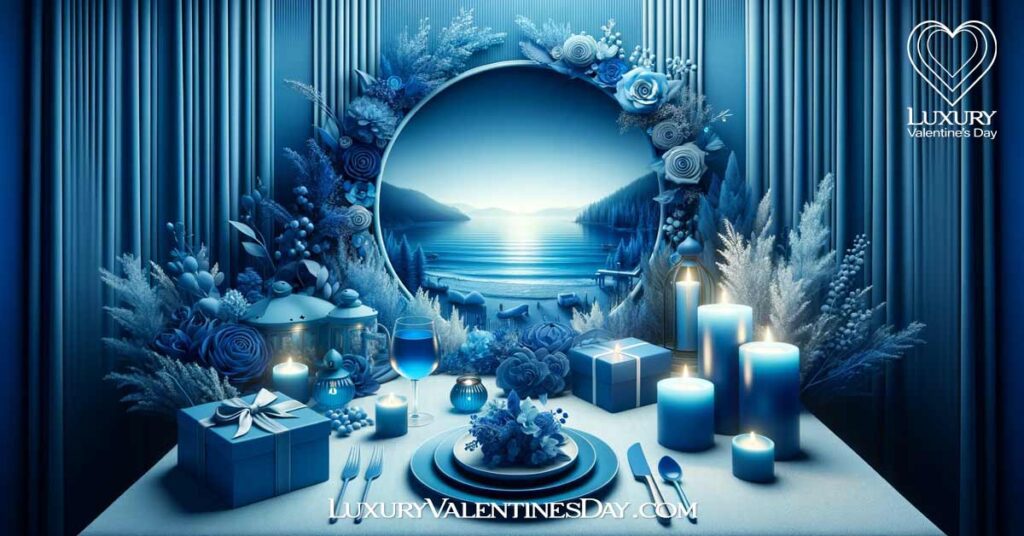
Is Blue a Valentine’s Day Color? Unveiling its Soothing Sentiments
While not traditionally linked with Valentine’s Day, blue has emerged as a color that brings its own unique charm to the celebration. It raises the question: Is blue a Valentine’s Day color? Indeed, blue symbolizes tranquility, stability, and a deep, trusting love. Evoking the calmness of the ocean and the vastness of the sky, blue invites a sense of peace and consistent affection. It represents the depth and reliability of a love that has stood the test of time, making it a meaningful and serene addition to the Valentine’s Day palette.
Weaving Blue into Valentine’s Day Elegance
Incorporating blue into Valentine’s Day can create an atmosphere of calm and enduring love.
- Tranquil Decor: Enhance the romantic ambiance with touches of blue. Consider soft blue lighting, table settings with blue accents, or decorations featuring shades of sky and navy blue for a tranquil yet elegant setup.
- Gifts of Trust and Loyalty: Blue-themed gifts can symbolize trust, loyalty, and stability in a relationship. Opt for a piece of jewelry with a sapphire or aquamarine stone, or choose gifts wrapped in blue for a thoughtful expression of enduring love.
- Fashion with Depth: Wearing blue clothing or accessories on Valentine’s Day can reflect the depth and stability of your feelings. A navy suit or a light blue scarf can be both stylish and symbolic of a deep, enduring connection.
- Culinary Delights in Blue: Experiment with blue-themed dishes or drinks, such as blueberry desserts or a blue curaçao cocktail. These not only add a unique twist to your menu but also offer a visual representation of the tranquility and depth of your love.
Integrating blue into Valentine’s Day celebrations provides an opportunity to celebrate love’s more profound, serene, and enduring qualities, making the occasion not just romantic, but also deeply meaningful.
Green: The Refreshing Touch of Valentine’s Day
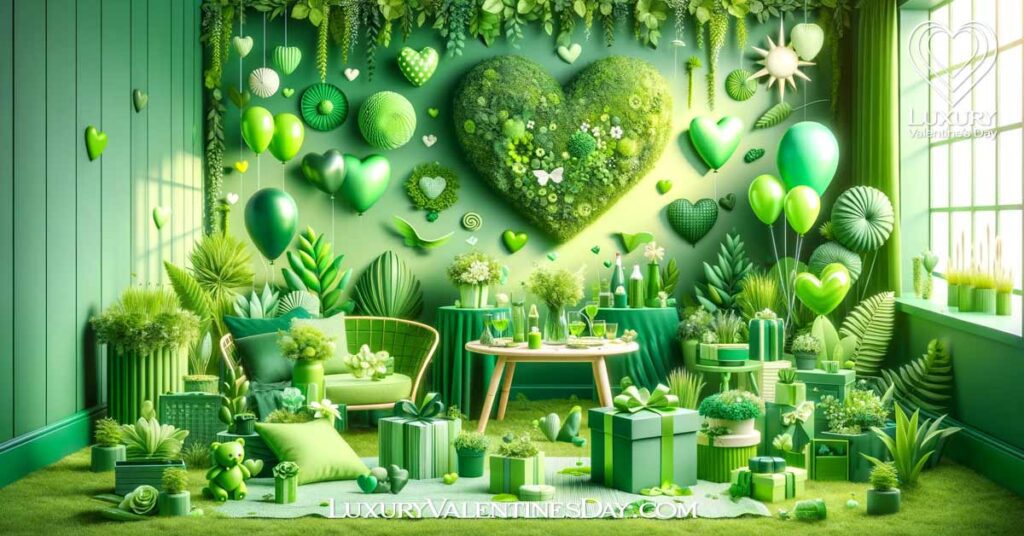
Green in Valentine’s Day – A Symbol of Growth and Renewal
Green may not be the first color that comes to mind for Valentine’s Day, but its significance in the celebration is undeniable. Symbolizing growth, renewal, and the flourishing of love, green adds a refreshing and nurturing dimension to Valentine’s Day. It represents the ongoing journey of a relationship, the continuous growth and rebirth that love experiences over time. Green’s association with nature and life makes it a perfect symbol for a love that is alive, thriving, and constantly evolving.
Infusing Valentine’s Day with Green’s Vitality
Incorporating green into Valentine’s Day celebrations brings a vibrant, life-affirming energy to the occasion.
- Natural Decor: Introduce green into your Valentine’s Day decor to create a fresh, vibrant ambiance. Use plants or greenery in your floral arrangements, or decorate with green ribbons and fabrics for a touch of nature’s vitality.
- Gifts that Grow: Embrace the symbolism of green by giving gifts that grow, such as potted plants or herb garden kits. These gifts not only symbolize the growth and renewal of your relationship but also offer a lasting reminder of your love.
- Eco-Friendly Fashion: Wearing green on Valentine’s Day can be a subtle nod to your commitment to growth and renewal in your relationship. Choose an eco-friendly green garment or accessory to make a statement about your sustainable values.
- Culinary Creations in Green: Add a touch of green to your Valentine’s Day meal with dishes that feature fresh, green ingredients. Think pesto pasta, a fresh green salad, or a minty dessert to bring a refreshing twist to your romantic dinner.
By integrating green into your Valentine’s Day celebration, you’re not just adding a pop of color; you’re embracing the essence of growth, renewal, and the ever-evolving nature of love.
Orange: The Vibrant Spark of Valentine’s Day
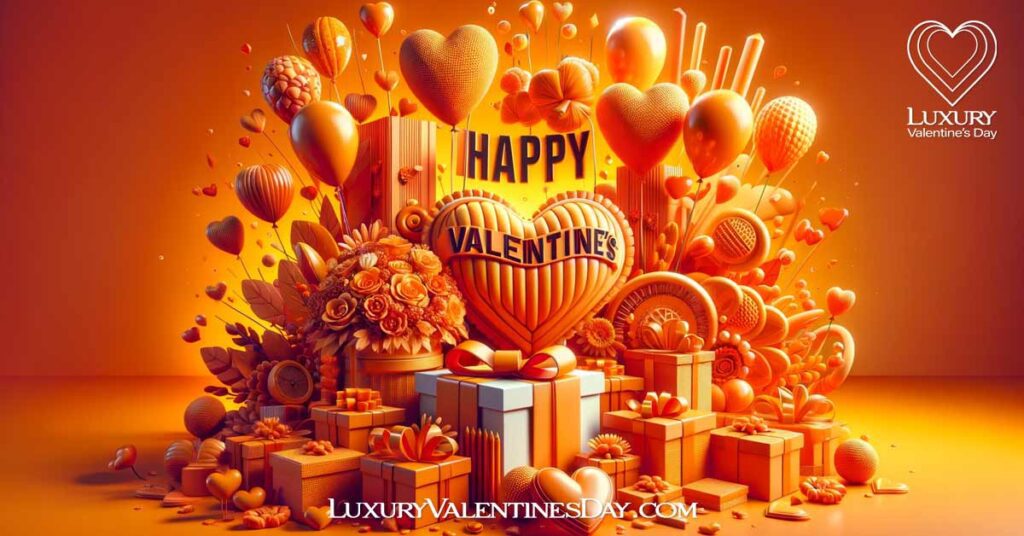
Embracing Orange’s Warmth and Enthusiasm in Love
While not traditionally associated with Valentine’s Day, orange brings a vibrant and energetic dimension to the celebration. This color symbolizes enthusiasm, warmth, and the invigorating spirit of love. It’s a color that captures the excitement and adventurous side of romance, reflecting the joy and passion in a relationship. Orange is a bold choice for Valentine’s Day, representing an unorthodox but equally heartfelt expression of love.
Igniting Romance with Orange’s Radiance
Incorporating orange into Valentine’s Day can infuse the occasion with a lively and spirited energy.
- Playful Decor: Add a burst of energy to your Valentine’s Day decor with orange accents. Consider using orange flowers, such as marigolds or tulips, for a cheerful and vibrant setting. Orange balloons, candles, or tablecloths can also bring a fun and lively atmosphere to your celebration.
- Adventurous Gifts: Embrace the spirited essence of orange by choosing gifts that reflect an adventurous and passionate side of love. Think of items like a spicy orange fragrance, vibrant orange accessories, or even tickets to a fun, upbeat event.
- Bold Fashion Choices: Wearing orange on Valentine’s Day is a statement of confidence and joy. Incorporate orange accessories or clothing items into your outfit to stand out and symbolize the vibrant nature of your love.
- Zesty Culinary Delights: Add a zing to your Valentine’s Day meal with orange-flavored or colored dishes. A citrusy dessert, a carrot ginger soup, or a refreshing orange cocktail can bring a lively and playful touch to your romantic dinner.
By weaving orange into your Valentine’s Day celebrations, you embrace a color that represents the joyous, enthusiastic, and adventurous aspects of love, adding a unique and vibrant touch to the day
Yellow: The Joyful Glow of Valentine’s Day

Uncovering Yellow’s Cheerful and Optimistic Love
Yellow, a color that radiates cheerfulness and optimism, adds a unique and joyful touch to Valentine’s Day. Often associated with the warmth of the sun and the vibrancy of spring, yellow symbolizes happiness, friendship, and the lighter side of love. It’s a color that brings a sense of playfulness and positivity, perfect for celebrating the joyful aspects of love and companionship. While not a conventional Valentine’s Day color, yellow offers a refreshing perspective on love, highlighting its fun, uplifting, and supportive nature.
Incorporating Yellow’s Sunshine into Valentine’s Celebrations
Integrating yellow into Valentine’s Day celebrations brings an element of brightness and joy to the occasion.
- Sunny Decor: Brighten up your Valentine’s Day setting with cheerful yellow decorations. Use yellow flowers, such as sunflowers or daffodils, to create a happy and inviting ambiance. Incorporating yellow elements like balloons, streamers, or table runners can add a sunny vibe to your celebration.
- Gifts of Joy and Friendship: Choose gifts that reflect the happiness and light-heartedness of yellow. Consider cheerful items like a sunny bouquet, a box of lemon-flavored sweets, or a bright yellow scarf to convey warmth and affection.
- Vibrant Fashion Touches: Wearing yellow on Valentine’s Day can express a joyful and optimistic approach to love. A yellow accessory or garment can add a bright and playful touch to your outfit, symbolizing the cheerful side of your relationship.
- Zesty Yellow Flavors: Delight in yellow-themed culinary creations to add a fun twist to your Valentine’s Day meal. Think lemon tarts, a creamy butternut squash soup, or a refreshing mango smoothie to infuse your romantic dinner with a burst of sunshine.
Embracing yellow in your Valentine’s Day celebration not only adds a pop of cheerful color but also celebrates the joyful, optimistic, and friendly dimensions of love, making the day feel even more uplifting and special.
Brown: The Earthy Embrace of Valentine’s Day

Discovering Brown’s Depth and Comfort in Love
Brown, a color often associated with stability, reliability, and comfort, brings an earthy and grounded dimension to Valentine’s Day. It symbolizes the solid, dependable aspects of love, representing the strength and resilience of deep-rooted relationships. Brown evokes a sense of warmth and security, akin to the comforting embrace of a loved one. While it may not be the traditional color of Valentine’s Day, brown offers a unique perspective on love, celebrating its enduring and supportive nature.
Integrating Brown’s Warmth into Valentine’s Celebrations
Incorporating brown into Valentine’s Day celebrations can create an atmosphere of comfort and trust.
- Cozy Decor: Utilize brown’s natural warmth in your Valentine’s Day decor. Consider earthy elements like wooden accents, rustic table settings, or brown-toned textiles to evoke a sense of stability and comfort. Decorations featuring chocolate browns can add a cozy and inviting feel to your celebration.
- Gifts of Enduring Affection: Choose gifts that reflect the comforting and reliable qualities of brown. Items like a leather-bound journal, artisan chocolates, or a cozy cashmere scarf can convey a message of enduring love and support.
- Earthy Fashion Choices: Wearing brown on Valentine’s Day can symbolize the strength and depth of your relationship. A stylish leather accessory or a warm brown sweater can subtly express the grounded and dependable nature of your love.
- Rich Culinary Delights: Embrace brown’s association with earthiness in your Valentine’s Day cuisine. Indulge in rich chocolate desserts, a hearty mushroom risotto, or a warm cup of gourmet coffee to add a comforting and satisfying element to your romantic dinner.
By weaving brown into your Valentine’s Day celebration, you honor the robust, nurturing, and dependable aspects of love, adding a layer of depth and warmth to the day’s festivities.
Grey: The Subtle Elegance of Valentine’s Day
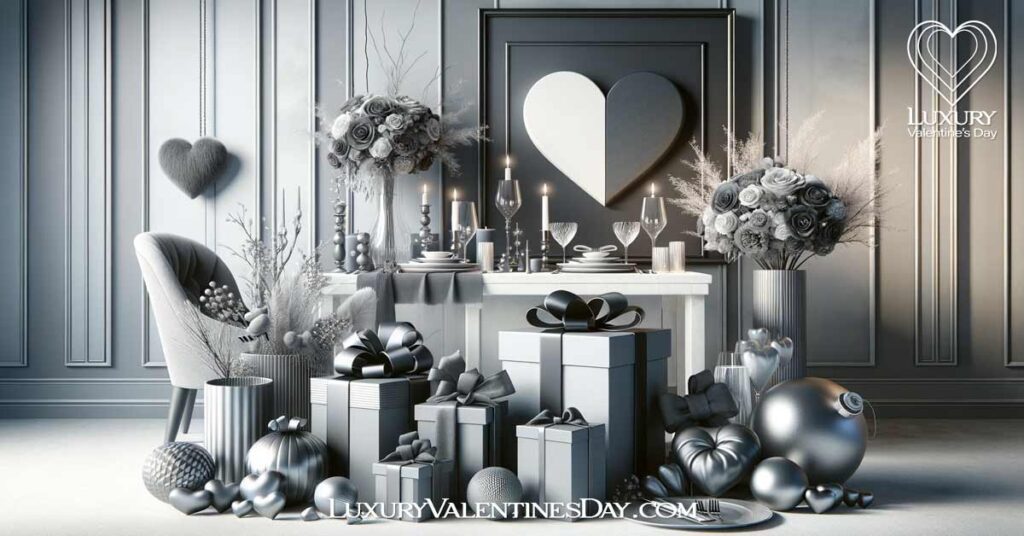
Embracing Grey’s Sophisticated and Balanced Love
Grey, often perceived as a neutral or understated color, carries its own elegance and sophistication in the context of Valentine’s Day. It symbolizes balance, maturity, and a harmonious blend of the black-and-white aspects of love. Grey represents the stability and calmness in a relationship, the steady foundation upon which passionate love can flourish. It’s a color that speaks to the resilience and enduring nature of love, making it a refined and subtle choice for Valentine’s Day celebrations.
Incorporating Grey’s Grace into Valentine’s Day Festivities
Introducing grey into Valentine’s Day celebrations can add a touch of refined elegance and understated charm.
- Sophisticated Decor: Enhance the ambiance with chic grey decorations. Use grey table linens, elegant silverware, or soft grey throws to create a sophisticated and serene setting. Incorporating metallic accents with a grey base can add a hint of glamour and luxury.
- Gifts of Understated Elegance: Opt for gifts that reflect grey’s subtle elegance. Consider sleek and modern items like a stainless-steel watch, a stylish grey scarf, or a set of luxurious graphite writing instruments to convey a sense of sophistication and thoughtfulness.
- Fashion with a Hint of Mystery: Wearing grey on Valentine’s Day can project an air of refined sophistication. A sleek grey dress or a sharp grey suit can be both stylish and subtly romantic, symbolizing the depth and maturity of your love.
- Culinary Sophistication in Grey: Experiment with grey-themed dishes or drinks, such as oyster mushrooms, truffle-infused pasta, or a classic Earl Grey tea. These not only add an element of culinary sophistication but also complement the subtle elegance of a grey-themed Valentine’s Day.
By incorporating grey into your Valentine’s Day celebration, you embrace a color that represents the balanced, mature, and sophisticated aspects of love, adding a layer of refined elegance to the festivities.
Black: The Intense Depth of Valentine’s Day
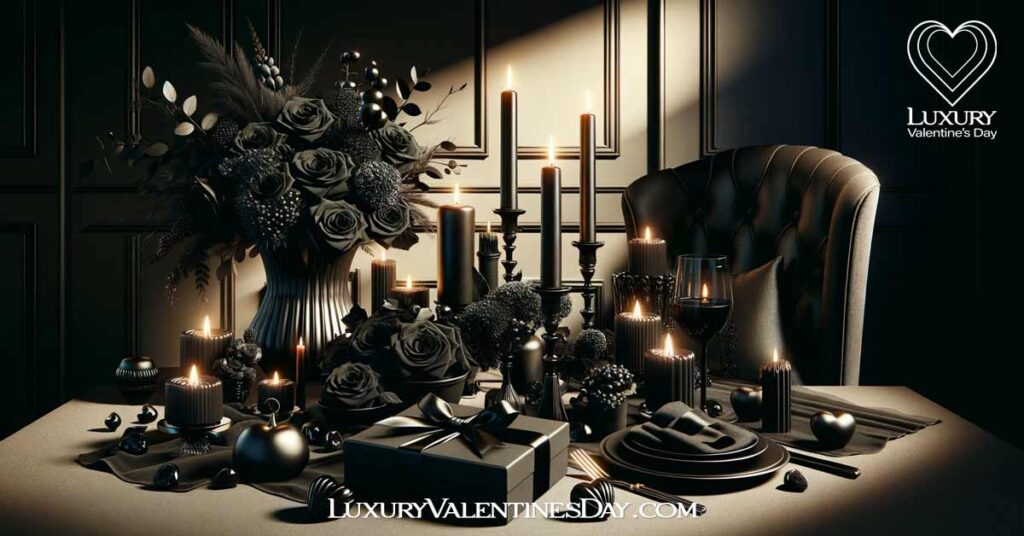
Unveiling Black’s Powerful and Elegant Love
Black, often associated with sophistication and depth, brings a unique intensity to Valentine’s Day. It symbolizes the depth of commitment, the strength of a bond that withstands all challenges. Black conveys an air of elegance and mystery, representing a love that is not only deep and enduring but also filled with passion and resilience. While unconventional for Valentine’s Day, black offers a bold and powerful perspective on love, celebrating its most profound and unwavering aspects.
Weaving Black’s Sophistication into Valentine’s Celebrations
Incorporating black into Valentine’s Day can lend an air of sophistication and depth to the celebration.
- Elegant Decor: Add a touch of dramatic elegance with black decorations. Consider using black table settings, candles, or even floral arrangements with dark hues like black roses for a striking and sophisticated look.
- Gifts of Depth and Elegance: Embrace the elegance of black with gifts that reflect its depth and sophistication. Items like black onyx cufflinks, a sleek black leather wallet, or an elegant black dress can convey a sense of profound love and refined taste.
- Fashion with a Bold Statement: Wearing black on Valentine’s Day can make a bold romantic statement. A classic black dress or a sharp black suit can exude sophistication, symbolizing the strength and intensity of your love.
- Culinary Delights with a Dark Twist: Experiment with black-themed culinary creations to add a unique touch to your Valentine’s Day meal. Consider dishes like squid ink pasta, black truffle risotto, or a rich dark chocolate dessert to bring an element of gourmet sophistication to your romantic dinner.
Integrating black into your Valentine’s Day celebration not only adds a layer of visual impact but also celebrates the profound, enduring, and passionate aspects of love, making the occasion deeply memorable and elegantly romantic.
White: The Pure Essence of Valentine’s Day
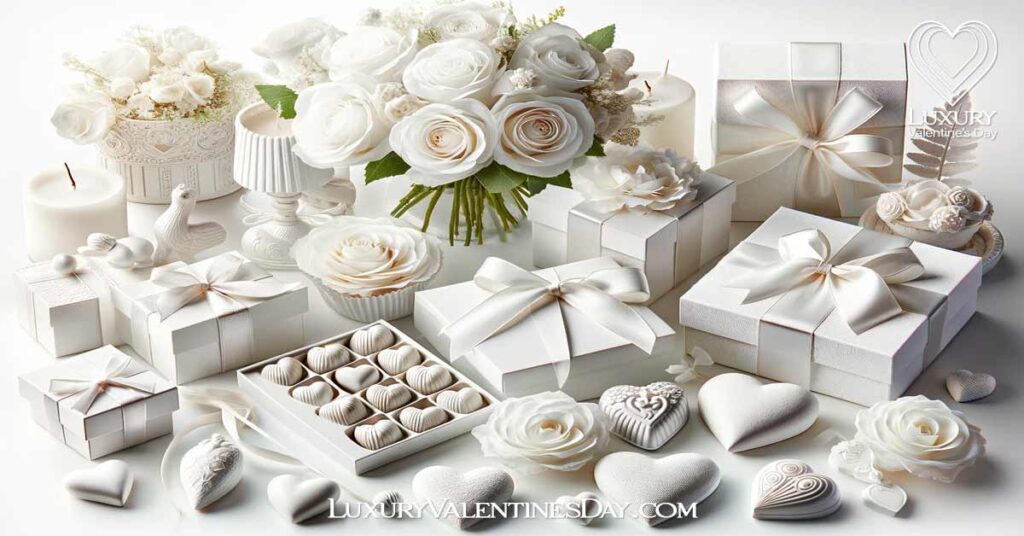
Celebrating White’s Symbolism of Purity and New Beginnings
White, a color often associated with purity, innocence, and new beginnings, brings a serene and peaceful dimension to Valentine’s Day. It symbolizes the fresh start of a budding romance, the clear and honest communication between partners, and the pure, unblemished nature of true love. White’s crisp and clean aura makes it a perfect representation of a love that is straightforward, sincere, and untainted. In the tapestry of Valentine’s Day colors, white offers a refreshing and calming perspective, celebrating love in its most genuine and unadorned form.
Infusing Valentine’s Day with White’s Serenity
Integrating white into Valentine’s Day celebrations can create an atmosphere of calm, purity, and fresh beginnings.
- Ethereal Decor: Craft a peaceful and pure setting with white decorations. Use white flowers like lilies or roses, elegant white tablecloths, or soft white candles to create a tranquil and pristine ambiance.
- Gifts of Simplicity and Elegance: Choose gifts that reflect the simplicity and elegance of white. Consider giving items such as a delicate white gold necklace, a luxurious white silk scarf, or a beautifully bound book with a pristine white cover.
- Fashion with a Touch of Innocence: Wearing white on Valentine’s Day can symbolize a fresh start or a pure intention. A crisp white dress or a classic white shirt can add a touch of innocence and simplicity to your look, reflecting the pure essence of your love.
- Culinary Delights in White: Delight your loved one with white-themed culinary creations. Think vanilla bean panna cotta, a creamy risotto, or a glass of chilled white wine to complement the theme of purity and elegance.
By incorporating white into your Valentine’s Day celebration, you embrace a color that represents the pure, serene, and sincere aspects of love, adding a layer of peace and clarity to the day’s festivities.
Silver: The Gleaming Splendor of Valentine’s Day

Reflecting on Silver’s Symbolism of Elegance and Modern Love
Silver, with its sleek and radiant presence, brings a touch of modern elegance to Valentine’s Day. It symbolizes clarity, sophistication, and a futuristic aspect of love. Representing the shining journey of a relationship and the resilience through various phases, silver adds a contemporary and refined dimension to the celebration. It embodies the sleekness of modern romance and the enduring strength of a bond that, like the metal, withstands the test of time. In the realm of Valentine’s Day colors, silver offers a sophisticated and forward-thinking perspective, celebrating love’s enduring luster and grace.
Illuminating Valentine’s Day with Silver’s Luster
Incorporating silver into Valentine’s Day festivities can infuse the occasion with a sense of refinement and contemporary elegance.
- Futuristic Decor: Create a sophisticated ambiance with silver accents. Use silver decorations, such as metallic balloons, shimmering table runners, or elegant silver candle holders, to add a touch of modern glamour to your setting.
- Gifts with a Sleek Edge: Choose gifts that reflect the sleek and modern qualities of silver. Items like a sterling silver watch, sophisticated silver jewelry, or a high-end tech gadget encased in a silver finish can convey a sense of modern elegance and thoughtfulness.
- Fashion with a Modern Twist: Wearing silver on Valentine’s Day can make a contemporary and chic statement. A shimmering silver dress or a stylish silver tie can exude sophistication, symbolizing the modern and enduring aspects of your love.
- Culinary Elegance in Silver: Add a sleek touch to your Valentine’s Day dining with silver-themed dishes or utensils. Consider serving a gourmet meal on silver platters or enjoying a cocktail with a silver-hued garnish to bring an element of contemporary refinement to your romantic dinner.
By weaving silver into your Valentine’s Day celebration, you honor a color that represents the elegant, modern, and enduring qualities of love, adding a layer of sophistication and futuristic charm to the festivities.
Lavender: The Whimsical Romance of Valentine’s Day
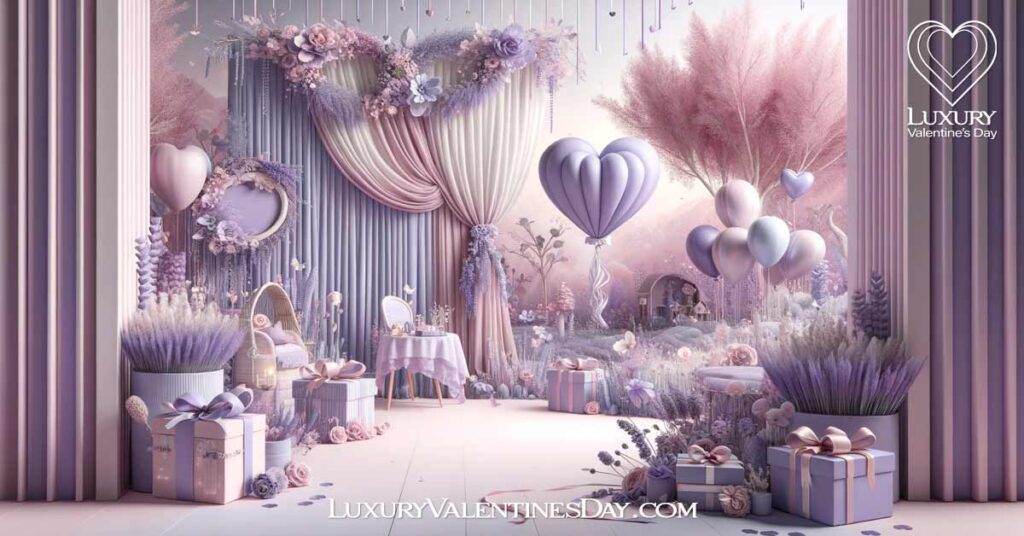
Lavender’s Enchantment and Dreamy Love
Lavender, with its soft and mystical hues, adds a touch of whimsy and enchantment to Valentine’s Day. It symbolizes grace, elegance, and the allure of a love that captivates and mesmerizes. Lavender represents a dreamy, gentle aspect of romance, evoking feelings of serenity, wonder, and an ethereal quality of love. Its delicate presence in the Valentine’s Day palette brings a unique and magical dimension to the celebration, ideal for those who treasure the more subtle and tender expressions of love.
Weaving Lavender’s Magic into Valentine’s Celebrations
Integrating lavender into Valentine’s Day can create an atmosphere of gentle romance and enchanting allure.
- Enchanting Decor: Set a dreamy and romantic scene with lavender decorations. Use lavender flowers, such as lilacs or wisteria, for a soft and whimsical ambiance. Incorporating elements like lavender-hued fabrics, ribbons, or candles can add a touch of magic and elegance to your celebration.
- Gifts with a Whimsical Touch: Embrace the ethereal beauty of lavender with gifts that reflect its delicate charm. Consider items like lavender-scented candles, a bouquet of fresh lavender, or a piece of amethyst jewelry to convey a sense of enchantment and grace.
- Fashion in Soft Hues: Wearing lavender on Valentine’s Day can symbolize a gentle and dreamy approach to love. A lavender dress or a subtle lavender tie can add a touch of whimsy and sophistication to your outfit, reflecting the delicate nature of your affection.
- Delicate Culinary Delights: Delight in lavender-themed culinary creations to add a dreamy twist to your Valentine’s Day meal. Think lavender-infused desserts, a light lavender cocktail, or dishes garnished with edible lavender for a subtle, romantic flavor.
By incorporating lavender into your Valentine’s Day celebration, you embrace a color that represents the gentle, enchanting, and whimsical aspects of love, adding a layer of dreamy elegance to the day’s festivities.
Purple: The Regal Splendor of Valentine’s Day
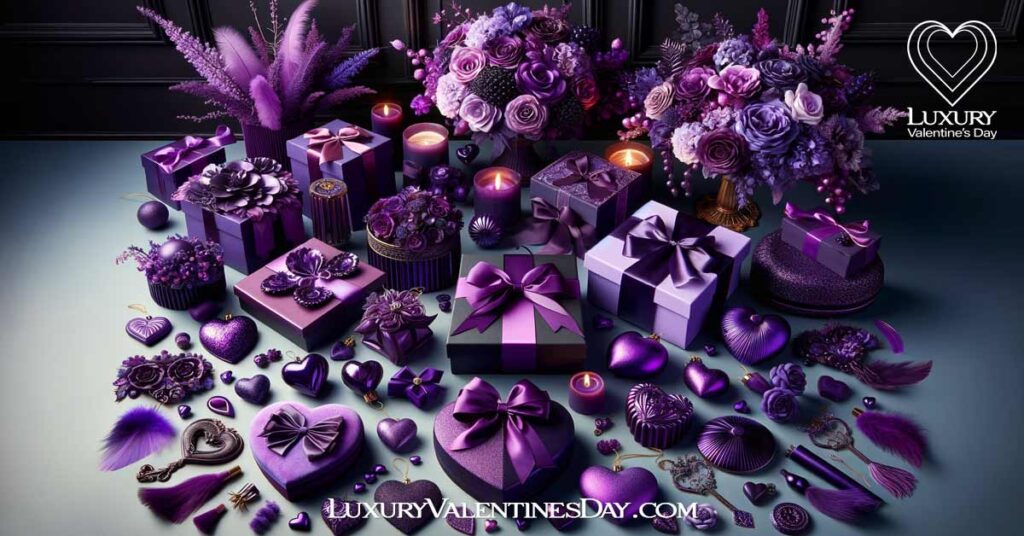
Is Purple a Valentine’s Day Color? Revealing its Royal Essence
When asking, “Is purple a Valentine’s Day color?” the answer is a resounding yes. Purple, known for its richness and depth, adds a layer of regal splendor to Valentine’s Day. This color symbolizes luxury, nobility, and a deep sense of devotion, making it a fitting choice for a day dedicated to love and admiration. Purple combines the fiery energy of red with the serene stability of blue, creating a harmonious blend that reflects a balanced and profound love. Its majestic presence in the Valentine’s Day palette brings an air of sophistication and depth, celebrating love in its most majestic and dignified form.
Adorning Valentine’s Day with Purple’s Royal Touch
Incorporating purple into Valentine’s Day festivities can infuse the celebration with a sense of luxury and grandeur.
- Luxurious Decor: Elevate your Valentine’s Day setting with opulent purple decorations. Use purple flowers, such as orchids or violets, for a regal and sophisticated ambiance. Elements like purple velvet tablecloths, plum-colored candles, or amethyst accents can add a touch of royal elegance to your celebration.
- Gifts of Majesty and Passion: Embrace the noble qualities of purple with gifts that reflect its luxurious and passionate nature. Consider items like a purple silk scarf, a set of amethyst cufflinks, or a beautifully crafted purple leather journal.
- Fashion with a Touch of Royalty: Wearing purple on Valentine’s Day can make a majestic statement. A deep purple dress or a rich violet tie can exude elegance and sophistication, symbolizing the noble and deep nature of your love.
- Regal Culinary Delights: Add a touch of majesty to your Valentine’s Day meal with purple-themed dishes or drinks. Consider dishes like beetroot risotto, a purple cabbage salad, or a lavender-infused cocktail to bring an element of regal charm to your romantic dinner.
By weaving purple into your Valentine’s Day celebration, you honor a color that represents the noble, luxurious, and passionate aspects of love, adding a layer of regal splendor to the festivities.
6 Facts about Valentine’s Day Colors
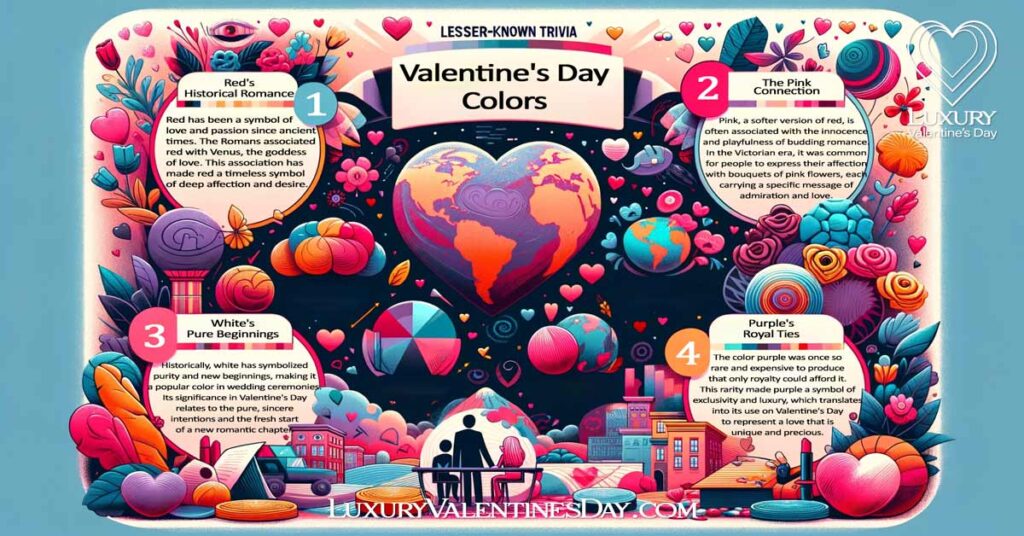
Valentine’s Day is not just about expressing love but also about the rich tapestry of colors that symbolize various aspects of affection and emotion. This section delves into some intriguing facts and trivia about the colors commonly associated with Valentine’s Day, shedding light on their historical significance and how they’ve come to be integral to this day of love.
1. Red’s Historical Romance
Red has been a symbol of love and passion since ancient times. The Romans associated red with Venus, the goddess of love. This association has made red a timeless symbol of deep affection and desire.
2. The Pink Connection
Pink, a softer version of red, is often associated with the innocence and playfulness of budding romance. In the Victorian era, it was common for people to express their affection with bouquets of pink flowers, each carrying a specific message of admiration and love.
3. White’s Pure Beginnings
Historically, white has symbolized purity and new beginnings, making it a popular color in wedding ceremonies. Its significance in Valentine’s Day relates to the pure, sincere intentions and the fresh start of a new romantic chapter.
4. Purple’s Royal Ties
The color purple was once so rare and expensive to produce that only royalty could afford it. This rarity made purple a symbol of exclusivity and luxury, which translates into its use on Valentine’s Day to represent a love that is unique and precious.
5. The Rise of Non-Traditional Colors
In recent years, there’s been a shift towards incorporating non-traditional colors like blue, green, and even black into Valentine’s Day celebrations. This change reflects a growing trend to personalize Valentine’s Day experiences and express love in more diverse and inclusive ways.
6. The Global Palette
Different cultures around the world incorporate various colors into their Valentine’s Day celebrations, each with its own unique meaning and symbolism. For example, in some East Asian cultures, pink and yellow are prominent colors for expressing love and good fortune.
For more fascinating insights and curious tidbits about this day of love, delve into our collection of 100 Valentine’s Day trivia.
The Kaleidoscope of Love – Embracing Colors in Valentine’s Celebrations

As we conclude our exploration of the vibrant world of Valentine’s Day colors, it’s clear that understanding the meanings behind these hues is more than just an artistic choice—it’s a way to deepen the emotional resonance of our celebrations. Each color, with its unique symbolism and history, brings a different dimension to the expression of love, making Valentine’s Day not just a date on the calendar, but a canvas for expressing the full spectrum of affection and emotion.
This journey through the palette of Valentine’s Day is a reminder of the power of colors to evoke feelings, convey messages, and create atmospheres. From the passionate reds to the elegant whites, and even the unconventional choices like tranquil blues or sophisticated blacks, each color offers a way to personalize and enhance your Valentine’s Day experience. They allow us to communicate the nuances of our relationships, whether it’s the fiery intensity of new love, the serene stability of long-term commitment, or the playful flirtations of a budding romance.
As you plan your Valentine’s Day, we encourage you to think creatively and choose colors that resonate with your personal love story. Don’t be afraid to break from tradition and infuse your celebration with colors that reflect your unique bond and individuality. Whether you’re setting the scene with decor, choosing the perfect gift, selecting your attire, or planning a romantic meal, let the colors you choose be a reflection of your feelings and the special connection you share with your loved one.
In the end, Valentine’s Day is about celebrating love in all its forms, and the colors we choose are the threads that weave together our expressions of affection, care, and commitment. So this Valentine’s Day, embrace the kaleidoscope of colors and let them add depth, joy, and meaning to your celebration of love.
FAQs: Navigating the Colorful Queries of Valentine’s Day

Valentine’s Day, with its rich palette of colors, often brings up various questions about how best to use and understand these hues in the context of love and celebration. Here, we address some common queries to help you make the most of these vibrant colors in your Valentine’s festivities.
Why is red considered the most popular color for Valentine’s Day?
Red has long been associated with love and passion, partly due to its connection with the heart and historically with the Roman goddess Venus. Its boldness and vibrancy make it a natural choice for expressing deep love and affection.
Can I use colors other than red and pink for Valentine’s Day?
Absolutely! While red and pink are traditional, incorporating other colors like purple, white, or even blue and green can add personalization and uniqueness to your celebration. Each color brings its own meaning and can reflect different aspects of your relationship.
What color should I choose for a Valentine’s gift if we’ve just started dating?
Lighter and softer hues like pink or lavender are perfect for new relationships. They symbolize the gentleness and sweetness of budding romance without the intensity that red might convey.
How can I incorporate multiple colors into my Valentine’s Day decor without it looking overwhelming?
The key is balance and harmony. Choose a primary color and complement it with softer tones. For instance, red can be balanced with white accents, or a deep purple can be softened with hints of lavender and silver.
What are some unique color combinations for a Valentine’s Day theme?
Consider pairing unconventional colors for a unique theme. For example, combine shades of blue and silver for a serene and elegant look, or mix shades of orange and yellow for a lively and vibrant theme.
Is it appropriate to use black in Valentine’s Day decorations?
Yes, black can be used for a sophisticated and elegant theme. Pair it with metallics like gold or silver for a luxurious look, or use it as an accent color to add depth and contrast to traditional reds and pinks.
How can I find out more about the meanings of different colors for Valentine’s Day?
Exploring resources on color theory and cultural color symbolism can provide deeper insights. Additionally, florists and designers are great sources of information on how different colors can convey various messages and emotions.
References
[1] “The Ultimate Guide to Flower Meanings” article on the Interflora website https://www.interflora.co.uk/page/flower-meanings
[2] “Basic Color Theory” article on the Color Matters website https://www.colormatters.com/color-and-design/basic-color-theory
Related Posts
- 10 Romantic Date Night Restaurants in Greensboro, NC: Culinary Love Affairs
- 10 Romantic Date Night Restaurants in Wilmington, NC: Your Guide to Unforgettable Evenings
- Classic Butter Cookies Recipe for Valentine’s Day: A Timeless, Buttery Delight
- Edible Glitter Decorated Cookies: Tips for Sparkling Designs
- The Dark Truth About Valentine’s Day
- Date Ideas That Start with V: Vibrant and Versatile Dates












